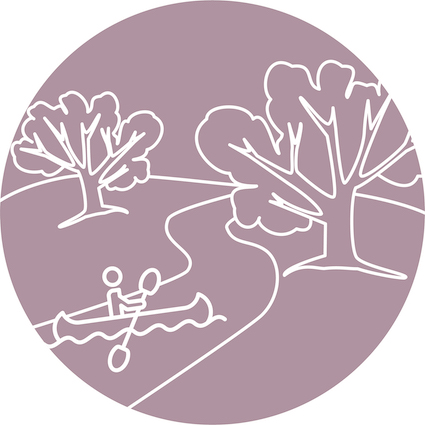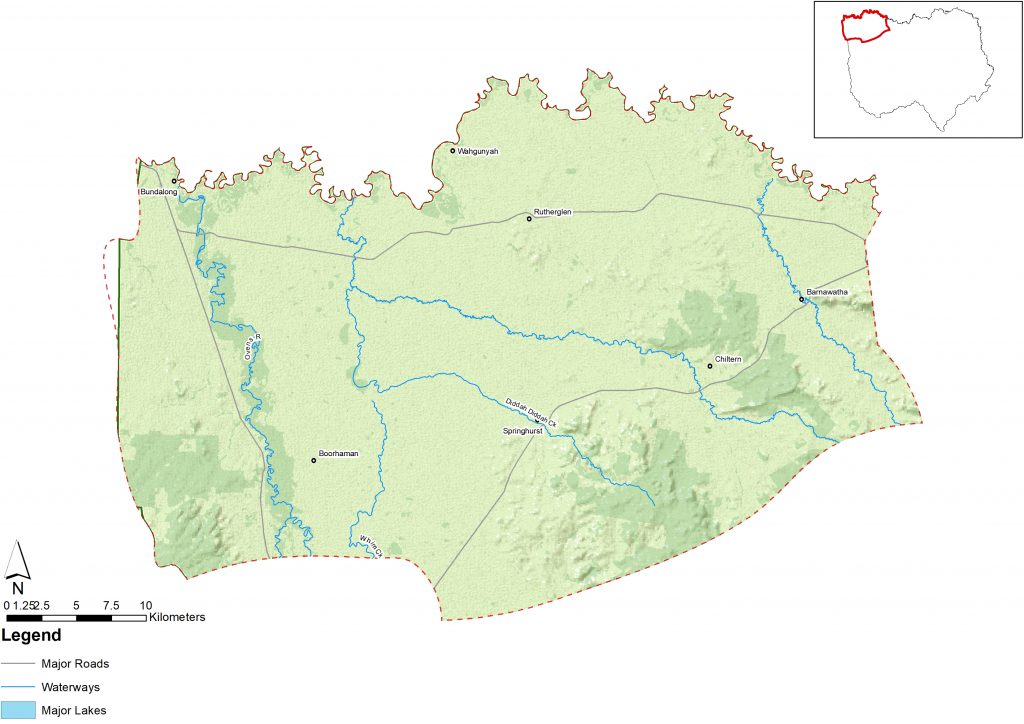
Vision
Thriving communities, biodiversity and agriculture supported by healthy and sustainable waterways, wetlands and groundwater systems
Introduction
Bordered by the Murray River, this riverine plain area supports a variety of agriculture, along with biodiversity hotspots such as the Warby-Ovens National Park.
Notable values include the unregulated heritage river (Ovens), extensive wetlands supporting important and threatened bird, frog and native fish populations. Sand hills across the landscape are also of cultural importance.
Lake Moodemere is a well-known corroboree and camping ground. It is also a well-known refuge, from 1892 to 1937, that offered a less restrictive alternative to the Missions. Traditional Owners/First Nations Peoples assembled in or were forced onto the refuge. It is documented that Tommy McRae, a renowned aboriginal artist, spent time at the refuge and it was an inspiration for his work.
Agriculture is an important employer with relatively large-scale mixed farming including grazing, horticulture and cropping. The Rutherglen area is also a renowned wine region.
The area has modest population growth. Regional towns include Rutherglen and Chiltern with several other small towns, villages and localities scattered across the area.
There is some evidence of increasing demand and market activity in agriculture, e.g. for groundwater-based development in the Lower Ovens.

What is important?
Important attributes
Important attributes of this landscape identified by those who live, work, visit or connect with this landscape include:
- Extensive network of wetlands that support important and threatened bird, frog and native fish populations. Black Swamp is listed in the Australian Directory of Important Wetlands for its ecological, educational, scientific, cultural and scenic features
- The unregulated Ovens River provides one of the most resilient natural refuges for aquatic life in the Murray-Darling Basin. The frequent flooding of the floodplain and wetlands of the Lower Ovens River plays an important role in cycling carbon and nutrients
- Significant Traditional Owners/First Nations Peoples cultural heritage sites, particularly around Lake Moodemere
- High land capability for agriculture around the riverine plains area that supports productive grazing, horticulture and cropping enterprises
- The Rutherglen area is a renowned wine region, particularly fortified wines, with a strong history of agricultural research and development
- The region supports a diversity of flora and fauna, including several distinct vegetation types and threatened species. The Warby Range is the only known community of the rare Spur-Wing Wattle (Acacia triptera) in Victoria and the Chiltern Mt Pilot National Park has one of the last four breeding sites in Australia for the threatened Regent Honeyeater (Anthochaera phrygia).
- Warby-Ovens National Park is the first site in Victoria to be admitted to the International Union for the Conservation of Nature (IUCN) Green List of Protected and Conserved Areas.
Key features
| Theme | Key features |
| Land | A forest landscape, dominated by river red gums, fertile alluvial plains, extensive networks of wetlands, sand hills and the Warby-Ovens National Park. High land capability with deep fertile soils and gentle slopes. Low vegetation cover in areas cleared for agriculture. The riverine plain land use is predominantly dry-land cropping and grazing, with some viticulture bordering the Murray River. Skeleton Hill, south of Chiltern, is an important landscape feature. Sand hills are a feature of this region and are of cultural importance. Chiltern – Mt Pilot National Park (21,560 ha) |
| Water | The heritage-listed Ovens River consists of several tributaries that flow into the Murray River including Black Dog Creek, Whim Creek, Diddah Diddah Creek and Indigo Creek. Lower Ovens River Wetland Complex comprises of Puzzle Bend, Lords Bend and Talbots Bend. The area has 1,000 ha of wetlands, and the majority is made up of freshwater meadows. Numerous billabongs and anabranches around Bundalong, Peechelba and Killawarra. Black Swamp, a nationally important wetland, lies at the junction of the Daddah Daddah and Diddah Diddah Creeks. Black Swamp is a group of five red gum, cane grass and herb shallow freshwater marshes in the floodplains of the Murray and Ovens Rivers. |
| Biodiversity | Black Swamp is a group of five red gum, cane grass and herb shallow freshwater marshes in the floodplains of the Murray and Ovens Rivers, in the Black Dog Creek catchment. The Chiltern-Mount Pilot National Park is an important remnant of native vegetation, particularly Box-Ironbark forest and a key habitat for critically endangered Regent honeyeater (Anthochaera phrygia). Significant areas of granitic woodlands of the Warby Ranges, Box-Ironbark in the Killawarras and the riverine forests and wetlands along the Ovens River. The stand of Mugga Ironbark north of Chiltern is significantly different to vegetation communities in the surrounding area. Remnant vegetation communities of Pine-Box Woodland and Plains Grassy Woodland feature in this landscape. Some important species and communities: Critically endangered seasonal herbaceous wetlands Flora Plains grassy woodland Box ironbark forest Mugga ironbark (Eucalyptus sideroxylon) Spur-wing wattle (Acacia triptera) Northern sandalwood (Santalum lanceolatum) Delicate leek-orchid (Prasophyllum aff. petilum) Terrestrial fauna Forest-woodland birds, such as: Brush-tail phascogale (Phascogale tapoatafa) Barking owl (Ninox connivens) Turquoise parrot (Neophema pulchella) Regent honeyeater (Anthochaera phrygia) Carpet python (Morelia spilota) Eastern snake-necked turtle (Chelodina longicollis) Koala (Phascolarctos cinereus) Southern rainbow skink (Carlia tetradactyla) Aquatic/riparian/wetland fauna Platypus (Ornithorhynchus anatinus) Freckled duck (Stictonetta naevosa) Musk duck (Biziura lobata) Rugose toadlet (Uperoleia rugosa) |
| Community | Regional towns include Rutherglen and Chiltern with several other small towns such as Bundalong, Wahgunyah and Springhurst. Other smaller villages and localities are scattered across the area. There is physical evidence of Traditional Owner/First Nations Peoples cultural values within the system and along the waterways in the form of scar trees and artefact scatters. Renowned food and wine culture and associated tourism and accommodation. Lifestyle landscapes (rural living and tourism) are centred on Chiltern and Rutherglen and based around their natural scenery and wineries. Agriculture is an important employer with relatively large-scale mixed farming including grazing (beef and sheep), horticulture (hops, wine grapes, vegetables) and cropping (maize, lucerne). |
Condition
The following is a snapshot of condition for the Riverina Lower Ovens Landscape.
| Theme | Condition |
| Land | Low to moderate capability of land across the landscape. Strategic agricultural land around Rutherglen is significant for versatility, scale, proximity to value-adding processing and for its access to secure water supplies. Soil health issues include – soil structure decline and organic matter loss and acidic soils. Soil carbon stocks are generally steady with potential for increases under current or altered land management. There are scattered areas between Whim Creek and the Ovens River where carbon stocks are declining under current land management. |
| Water | Waterways in this landscape are in moderate condition and in-stream woody habitat is severely depleted (greater than 80% of what would be expected under natural conditions).[66][67] The heritage listed Ovens River provides one of the most resilient natural refuges for aquatic life in the Murray-Darling Basin. Drier conditions have led to decreased inflows into rivers, however, there is still strong reliability of water supply which provides a competitive advantage and supports a diversity of agricultural enterprises. Recreational values are now explicitly considered in seasonal watering proposals for the Ovens River. There is increasing irrigation development and a high dependency of the community on groundwater for stock and domestic use. |
| Biodiversity | There is a highly concerning trend of biodiversity decline due to land clearing and development, pest plants and animals, river regulation, water pollution and climate change. Seasonal herbaceous wetlands in this landscape are critically endangered ecosystems. Riparian corridors along the lower Ovens are key zones of high biodiversity value. The quality of the riparian vegetation in this area is generally high. Fish communities of the river reaches are only in moderate condition. The relatively intact river red gum canopy associated with the Murray River floodplain is considered one of the healthiest in the Murray-Darling Basin. The threatened crimson spider-orchid (Caladenia concolor) occurs in the Chiltern area. The Chiltern-Mt Pilot National Park reserves some of the few remaining wild individuals of this species. The Chiltern-Mt Pilot National Park is in relatively good condition despite its mining history and associated weed occurrences. Ancient, remnant and paddock trees are in decline. High conservation value areas exist, however large sections are degraded due to agriculture and historical gold mining. Roadside vegetation, remnant vegetation on private land, unused road reserves and wetlands play an important role in providing corridors and linkages with the Ovens River and the Murray River. |
| Community | Community involvement in the system is strong, with active community groups engaged in supporting NRM. There are older residents, fewer younger residents, smaller household sizes and lower incomes than other areas in the region. There are lower proportions of the population with degrees and greater employment in blue collar industries such as agriculture. There is modest population growth and low multiculturalism and diversity. Increasing land prices – such as on the fringes of urban areas around Rutherglen, where value is influenced by amenity pressures and high value horticulture (wine grapes). Rutherglen’s population is changing and becoming increasingly wealthy, while Chiltern and Wahgunyah are relatively unchanged towns. Strong economy in agriculture and retail manufacturing both associated with the renowned viticulture of the area. |
What is changing?
The world and our region are changing rapidly and north east Victoria is more interconnected across multiple spatial scales than ever before. This section describes the major drivers of change and what this means for the Riverina Lower Ovens landscape.
Drivers of change
| Driver of change | Leading to |
| Climate change and acute shocks and extreme events | Increased frequency of extreme events including storms, floods, droughts and blue green algae and fire. Bushfire smoke impacting negatively on vineyard harvest. Declining average rainfall and reduced stream flow in waterways. Alterations to commodities that can be supported with changing climate. |
| Farms are changing – they are increasing in size and the use of irrigation is growing | Increased competition for, and stress on, surface and groundwater resources. More intensive use of farmland may lead to potential reduction in vegetation cover (e.g. remnant paddock trees) and increases in stocking rates. Labour replacement with mechanical options – as farms consolidate and agricultural innovation increases. Improved efficiency of inputs, such as fertiliser, chemicals and irrigation, due to rising input costs and declining terms of trade. Increased demand for groundwater resources and concern about future reliability for stock and domestic supply. |
| Decline of ancient, remnant, and paddock trees. | Reduced ecological function due to increased fragmentation and habitat loss. Increased community interest in retaining natural landscape values and protecting ancient trees – opportunity to enhance. Opportunity to increase linkages and corridors between current ancient, remnant, and paddock trees. Climate change is likely to further impact the condition of remnant habitat and reduce the ability for ecosystems to respond to other threats, such as those arising from agriculture and land use changes. |
| Strengthening empowerment of Traditional Owners/First Nations Peoples | Recognition and protection of cultural values associated with the lower Ovens. Increased community awareness of rich Aboriginal culture of the lower Ovens and desire from communities to learn more. Greater collaboration between public land managers and Traditional Owners/First Nations Peoples. |
| Changes in demographics and move to service economy | Population, dwelling and industry growth in Barnawartha. Commuters working in urban areas are moving into the landscape providing opportunities for investment in the region and revitalisation of the community. New families moving into areas and reinvigorating communities. |
| The threat of sand mining is a concern to some parts of the community | Impacts to landscape amenity – the sand hills are a distinctive landscape feature. Impact to cultural values and disturbance of ancient artefacts. Community division and land use conflict between urban, lifestyle, commercial agriculture and mining. |
| Changing Lower Ovens and wetland water regimes | Potential conflict arising from competing demands for water resources e.g. between potable, agricultural, environmental and cultural. Increased community awareness and interest in protecting the natural values of the lower Ovens River system. Increase protection of cultural values associated with the lower Ovens. |
Outcomes and priority directions
Key outcomes and priority directions for the RCS have been developed drawing on information and discussions with people who live, work, visit and connect with north east Victoria at a regional and local scale.
Outcomes and their associated priority directions, that are important to the Foothills – mid Ovens and King from the regional themes of biodiversity, water, land and community include:
Biodiversity
- By 2040, an increase in the extent (ha) and connectivity of native vegetation across north east Victoria.
- By 2040, an increase in the area of natural environments protected and remnant vegetation enhanced.
- By 2040, improved trajectories for priority native icon, threatened and culturally significant species and ecological communities (priority species and communities).
- By 2040, an increase in the understanding and focus on supporting resilient biodiversity in a changing climate.
Land
- By 2040, land management practices are culturally appropriate reflecting Traditional Owners/First Nations Peoples aspirations.
- By 2040, community resilience and land management practices are continually adapting to accommodate challenges of climate change and extreme events.
Community
- By 2040, an increase in the number and diversity of individuals and organisations supporting Landcare and Community NRM groups in north east Victoria.
- By 2040, an increase in participation by visitors and absentee landholders caring for, and stewarding the natural environment across north east Victoria.
- By 2040, an increase in diversity of investment in NRM in north east Victoria.
- By 2040, Traditional Owners/First Nations Peoples’ knowledge and practice is healing, adapted to a contemporary context and applied to both heal and care for Country.
Water
- By 2040, waterways are healthy and well managed thereby protecting waterway dependent iconic, culturally important and threatened (priority species) species.
- By 2040, there is improved protection of water quality and waterway/wetland/floodplain system values during and following extreme events.


